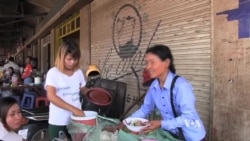A study by the International Labor Organization, the U.N.’s labor body, shows most Cambodian garment workers do not eat enough nutritious food and that, as a result, many are anemic and even underweight. Now, a pilot project will feed workers at five factories a free daily meal for the next year and measure their health and productivity. The idea is to persuade factories and the Cambodian government of the economic benefit of providing free meals.
It’s 11 a.m. outside the Gladpeer garment factory in Phnom Penh, and workers stream out to buy lunch from roadside vendors.
Among them is 21-year-old Phon Chany. She earns $130 a month working up to 14 hours a day, $20 goes on rent and electricity, and $50 to support her parents and seven siblings in their village. That doesn’t leave much. To get by, Chany scrimps on food - which brings other costs.
“I regularly get fevers and headaches - firstly because I don’t eat enough, and secondly because I work long hours and don’t get enough sleep,” she said.
Cambodia’s garment sector is worth $5.5 billion annually. Some 600 factories produce for brands like Levi-Strauss, H&M, and Walmart. But the sector’s 600,000 workers, mainly young women like Chany, struggle on the $100-monthly minimum wage.
The ILO’s study of nearly 4,000 workers found 43 percent are anemic, and 15 percent are underweight.
Although Cambodian garment workers have the benefit of a monthly paycheck, their health metrics were, unexpectedly, no better than the rest of the population in the impoverished country.
“Also we were surprised at how little workers spend on food. So they are saying that on average they are spending about $9 a week, or $36 a month, but they make much more than that. So they’re sending a lot of money home and using it for other purposes," explained Jill Tucker, International labor organization. "Workers are essentially starving themselves so that they can contribute to their families’ welfare.”
For the next year, workers at five factories will get one free meal a day; workers at another five will not. The ILO will measure the health and productivity outcomes.
Dave Welsh heads the Solidarity Center, a group affiliated to the U.S. labor movement. Welsh says the impact of the nutrition project and the ongoing talks to boost the minimum wage mean Cambodia has the chance to deliver on its reputation as hosting a model industry.
“It’s not just increasing the monetary amount of the minimum wage, but looking at subsidizing where most of those expenses go to, and, currently, most of those expenses go to housing for sub-standard housing and food for sub-standard nutrition that’s provided to workers. If you eliminated the nutrition aspect of that, it could arguably be a saving of as much as 50 percent of what workers are currently earning,” Welsh said.
A daily free meal and a higher minimum wage whose benefits are not lost to higher rents and food prices, labor activists say, would dramatically improve the lives of Cambodia’s garment workers.








